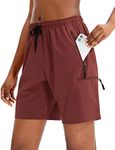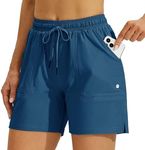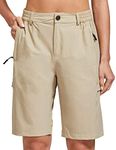Buying Guide for the Best Hiking Clothes For Women
Choosing the right hiking clothes is essential for comfort, performance, and safety on the trail. The right gear can protect you from the elements, regulate your body temperature, and prevent injuries. When selecting hiking clothes, consider the climate, terrain, and duration of your hike. Layering is key, as it allows you to adjust your clothing to changing weather conditions and activity levels. Here are some key specifications to consider when picking hiking clothes for women.MaterialThe material of your hiking clothes is crucial for comfort and performance. Synthetic fabrics like polyester and nylon are popular because they wick moisture away from your skin, dry quickly, and are lightweight. Merino wool is another excellent option as it is breathable, moisture-wicking, and has natural odor-resistant properties. Cotton should be avoided as it retains moisture and can lead to chafing and discomfort. Choose materials based on the weather conditions and your personal comfort preferences.
LayeringLayering is a system of wearing multiple layers of clothing that can be added or removed to regulate body temperature. The three main layers are the base layer, mid layer, and outer layer. The base layer should be moisture-wicking to keep sweat away from your skin. The mid layer provides insulation and retains body heat, with options like fleece or down jackets. The outer layer, or shell, protects against wind, rain, and snow, and should be waterproof and breathable. Consider the climate and intensity of your hike to determine the appropriate layers.
FitThe fit of your hiking clothes affects both comfort and mobility. Clothes that are too tight can restrict movement and cause chafing, while clothes that are too loose can get caught on branches or other obstacles. Look for a fit that allows for a full range of motion without being too baggy. Try on clothes and move around to ensure they are comfortable and functional. Consider your personal preference for a snug or relaxed fit, and remember that layering may require a slightly looser fit.
BreathabilityBreathability refers to how well a fabric allows moisture vapor to escape, keeping you dry and comfortable. This is especially important during high-intensity activities or in warm weather. Fabrics like polyester, nylon, and merino wool are known for their breathability. Look for clothes with ventilation features like mesh panels or zippered vents to enhance airflow. Choose breathable clothing to prevent overheating and maintain comfort on the trail.
Weather ResistanceWeather resistance is the ability of your clothing to protect you from wind, rain, and snow. Waterproof and windproof materials are essential for staying dry and warm in adverse conditions. Look for clothes with durable water repellent (DWR) coatings or waterproof membranes like Gore-Tex. Consider the typical weather conditions of your hiking destinations and choose clothing that offers the appropriate level of protection. For mild conditions, water-resistant clothing may suffice, while more extreme weather requires fully waterproof gear.
WeightThe weight of your hiking clothes can impact your overall comfort and energy levels. Lightweight clothing is generally preferred as it reduces the load you have to carry and allows for greater freedom of movement. However, lightweight options should not compromise on durability and protection. Consider the balance between weight and functionality, and choose clothes that are light enough for comfort but still provide the necessary protection and durability for your hike.
DurabilityDurability is important to ensure your hiking clothes can withstand the rigors of the trail. Look for reinforced stitching, abrasion-resistant fabrics, and high-quality materials that can endure rough terrain and frequent use. Durable clothing may be slightly heavier, but it will last longer and provide better protection. Consider the type of terrain and frequency of your hikes to determine the level of durability you need. Investing in durable clothing can save you money in the long run by reducing the need for frequent replacements.
Pockets and StoragePockets and storage options are useful for carrying small essentials like maps, snacks, and gadgets. Look for clothes with multiple pockets, including zippered or secure pockets to keep items safe. Consider the placement and accessibility of pockets to ensure they are convenient and do not interfere with your movement. Think about what items you typically carry and choose clothing with adequate storage options to keep your essentials within easy reach.




















